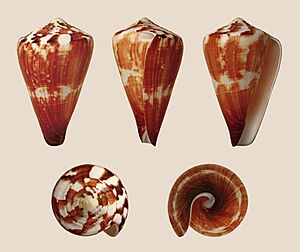Conus vexillum facts for kids
Quick facts for kids Conus vexillum |
|
|---|---|
 |
|
| Shell of Conus vexillum Gmelin, 1791 | |
| Scientific classification | |
| Synonyms | |
|
Conus vexillum, also known as the vexillum cone or flag cone, is a type of sea snail. It's a marine gastropod, which means it's a kind of mollusk that moves on a "stomach-foot." This snail belongs to the Conidae family, often called cone snails.
These snails are predatory, meaning they hunt other animals for food. They are also venomous. Because they can "sting" humans, it's very important to be careful around live ones. It's best not to touch them at all.
What Does It Look Like?
The shell of the vexillum cone can be quite big. It usually measures between 27 and 186 millimetres (1.1 and 7.3 in) long. The shell is large but also somewhat thin.
The top part of the shell, called the spire, has thin lines or grooves. The shell's main color is yellowish or chestnut brown. It often has a white band around the middle, though this band can sometimes be hard to see. Sometimes there's another broken white band near the top of the shell.
The spire itself has a mix of white and broad chestnut-colored patterns that look like flames. These darker patterns often spread onto the lighter chestnut color of the main part of the shell, called the body whorl.
Where Do They Live?
The vexillum cone snail is found all over the Indo-Pacific region. This huge area stretches from Natal in Africa all the way to Hawaii and French Polynesia. You can also find them from Japan down to Australia, including the Northern Territory, Queensland, and Western Australia.
There's a special type of this snail, called Conus vexillium sumatrensis, which only lives in the northwest part of the Indian Ocean.
Habitat and Lifestyle
Young vexillum cone snails live in shallow areas, like tidal pools and rocky shores. Adult snails prefer deeper water, usually along coral reefs, down to about 30 metres (98 ft) deep.
Around the Hawaiian Islands, these snails are found even deeper, between 50–70 m (160–230 ft). People have seen them in many different places, such as shallow lagoons, sandy areas, sandy areas with small rocks, among seaweed or rocks, and even under dead coral.
This snail is known for being tough and can live in rough ocean waters. The vexillum cone snail eats eunicid polychaetes, which are a type of marine worm.
Gallery




